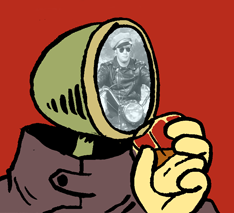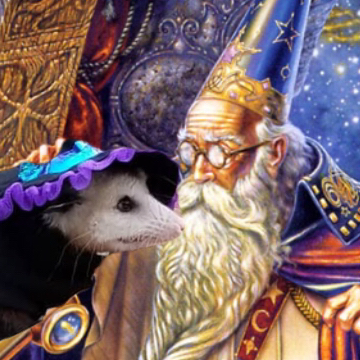Image from 2022 using infrared imaging with the goal of spotting clouds on Titan. The white spot that looks like a bubble reflection on the upper right of the image (1 o’clock?) is a cloud.
This is not true color, but colors assigned to different the wavelengths that we otherwise cannot see. Visible light would not have allowed imaging deep enough into the atmosphere to see clouds.
Surely you mean “to see anything but clouds”, right?
Nope! They got to see two cloud actually! A second set of images exists from Keck Observatory with the other cloud.
The thick atmosphere isn’t cloudy, just dense with methane.
I’m not 100%, but the clouds are exciting I think because they demonstrate seasonal changes.
A clearer picture, for those interested:
http://annesastronomynews.com/wp-content/uploads/2012/02/Titan.jpg
From the source:
Titan is the only object other than Earth where liquid hydrocarbon lakes and seas have actually been found (by Cassini) in its polar regions – in abundance in the north polar region and at least one of approximately 20,000 km2, called Ontario Lacus, on its south pole. Just recently, there have also been long-standing methane lakes, or puddles, in Titan’s “tropics” discovered.
Titan is the only object other than Earth where liquid hydrocarbon lakes and seas
The US would like to know your location
For some reason, there are terrorists on Titan. The USA is preparing the Space Marines
A division of space force.
Led by Johnny Space
Chief Medic: Dr. Spaceman
Pronounced Spa-sche-min
*No 30 Rock fans here, I see.
This makes me wonder what would happen if someone ignited large explosives by some of these hydrocarbon pools… since there’s plenty of water ice, there’s oxygen tied up to react with…
It looks far less habitable up close lol.
Why the blur if the telescope is so powerful?
Titan is small, and distant, when compared to the photo in the thread.
The photo in this thread is by Cassini, which was at least a thousand of times closer. Titan is 1.2 million KM from Saturn, which Cassini was orbiting, while Earth, which JWST “orbits” is at least 1.2 billion KM from Saturn.
Thanks for the clarification!
With its liquids (both surface and subsurface) and robust nitrogen atmosphere, Titan’s methane cycle bears a striking similarity to Earth’s water cycle, albeit at the much lower temperature of about 94 K (−179 °C; −290 °F).
That’s way too cold in my opinion!
The future ski holiday destination of the rich
Humans are pretty good at warming things up
These are not photographs I think? It’s computer generated.
These are photographs, actually
Well, are they gonna let it out before Saturn notices its missing??? Saturn’s a big planet, I hope it doesn’t notice
Gotta catch em all!
I can’t wait for the conspiracy theorists to say it has water oceans.
Umm it pretty clearly does.
Source: it comes in blue
That’s just what Big Primary Colors want you to think.
Yeah, to sell printer ink.
People who instantly believe every thought that occurs to them aren’t conspiracy theorists per se, but there’s not a lot of cleavage in that Venn diagram.
Isn’t that an actual scientific theory about it? That it could have an ocean of liquid water under the surface of ice? Maybe I’m thinking of a different moon…
That’s Europa. The thinking is that Europa may have life in its oceans beneath the ice that feed off of geothermal vents and therefore don’t require any sunlight.
Okay but are they delicious?
No, but you can make an anti-aging cream from their fat.
Almost looks like earth but with more land than water.
In infrared. Titan basically looks like a brownish grey blob to the naked eye due to its incredibly dense atmosphere.
Knowing it’s just color shifted makes me wonder if that white band in the upper right that looks like a reflection off the atmosphere is actually a reflection off the atmosphere. And also what method of color shifting was used. Are the colors representative of anything or did they just pick what made for the best photo?
They basically remap wavelengths, so yes, absolutely those would be representative of real features, either in the atmosphere or on the ground.
That said, absolutely, sometimes there’s a bit of artistic license in how the wavelengths are mapped.
Edit: the space.com article on the image describes some of the physical features depicted:
https://www.space.com/james-webb-space-telescope-saturn-moon-titan
Titan is about 40% the size of the planet Earth, and is the 10th largest object in the solar system.
Going from memory here…
Sun, Jupiter, Saturn, Uranus/Neptune (don’t recall which order those two belong in), Earth, Venus, Mars, Mercury, then finally Titan.
I’ll look it up in a moment, but I wanted to post off the top of my head.
deleted by creator
No, I didn’t forget Pluto. It isn’t chonky enough to be in that list (but it still has a place in my heart ❤️).
See, Pluto’s radius is about 0.19 Earths vs. Titan’s 0.4 Earths – or, by mass, Pluto is 0.00218x Earth vs. Titan being 0.0225x Earth
⚪️ < actual size
😂
Ah! I was a little off. Ganymede and Titan are BOTH larger than tiny little Mercury.
Only one has sea rats, though.
Whoosh! I think I just missed a reference.
what are the colors? I’m guessing thats not visible spectrum
yeah, i believe that JWST can’t see visible spectrum at all, so this must be infrared light
Very blurry for a powerful telescope. Wonder if it’s because moon is moving fast relative to close telescope so the effective shutter speed needs to be relatively high?
Have we ruled out that the moon might just look like that? Like all fuzzy? How 'bout it, NASA?
Titanically baked, blaze new world
deleted by creator
JWST primarily looks at very large objects that are far away. Titan (and really everything in the solar system) is relatively close to us, but are tiny in comparison to galaxies/nebulae, so their actual size as they appear in the sky is a lot smaller.
Also of note, most objects in the outer solar system are very dim.
Can’t really claim we’re all that bright in the inner solar system either.
Must’ve left his glasses back on Earth
Subtle dig at Hubble, I like it
I would assume it’s because the object is too close. Like trying to do macro photography without a macro lense.
It’s just mipmaps, high res texture is still loading.
Yooooo! It’s beautiful!!! 😍
odd that it can pick up light from the universe’s placenta but can’t get a good shot of that kid down the street
remember that JWST doesn’t do visible spectrum and, regardless, it’s specialized for faint distant objects. From JWST’s perspective, Titan emits a lot of light. It’s kind of like using a telephoto lens to take a picture of your foot.
People in general don’t understand focal length and spectrums. It’s just oooh 400x zoom, fancy, let’s see atoms.
deleted by creator
no just wipe your screen, clears right up /s
Cassini took closer pictures if you need some.
No it’s not.

Est-ce que j’ai l’air de savoir ce qu’est un JPEG?
The bad English makes it read as if there are other, larger, moons of Saturn, but the JWST hasn’t captured them yet.
I think I need glasses.
People saying this is blurry… have you considered: every other image is stitched, edited, overlaid and colorized, whereas this is a picture that’s actually quite close to that from the camera of JWST.
JWST doesn’t see visible light, so it’s blurry and false color.
But JWST also wasn’t designed to take pictures of moons in our solar system, it was designed to take picture of the cosmic background and find stars with planets around them.
This is like trying to use a telescope to look at your globe across the living room, it’s going to be blurry because it wasn’t designed for that.













